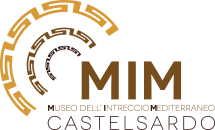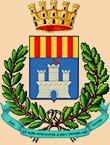Museo dell'intreccio mediterraneo di Castelsardo
Main site sections
Coiled basketry
In Sardinia, the varying distribution of the weft fiber on the warp determines the distinction between two different compositional techniques: coiling and twining. To these we can add the techniques used for roofing and mats; for sacred occasions or ceremonies, like the Easter palms; for the caning of the typical Sardinian kitchen chairs; for articles used in daily work activities depending on the type of work involved; fishing creels or breadbaskets.
The coiling technique begins with a spiral warp around which the plant fiber is wrapped and sewn with spiral stitches using a perforating tool made of either metal or animal bone.
The various basket shapes (truncated conical, semispherical, etc.) are obtained by varying the angle of attachment of the new coil to the previous one.
Typical examples of the coiling technique are found in the baskets called, in Campidano and Logudoro, “strexiu ‘and fenu” or “sa scrarìa” and “paneri” in Castellanese, a set of containers made up of breadbaskets and corbule (with an inverted truncated conical shape)
The varying types of plant fiber used characterize the type of artifact.
Baskets can be divided into those with:
- Warp made of wheat culms (stems) and weft of reeds, produced in the grain-growing areas of: Campidano of Cagliari and Oristano, Trexenta and Marmilla;
- Warp and weft of asphodel, made in highland areas like: Planargia, Montiferru, Ogliastra and some towns in the Barbagia di Ollolai region such as Ollolai and Olzai ;
- Warp made of sea hay or wheat culms and weft of Dwarf palm fiber or raffia produced in Castelsardo and in the communities of Anglona, Algherese, Logudoro, Romangia and Gallura.
- Warp of wheat culms or sea hay and weft of Dwarf palm fiber or raffia.
Other possible variations depend on the artistic composition of the decoration.



